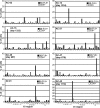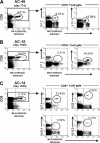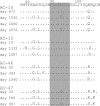Fluctuations of functionally distinct CD8+ T-cell clonotypes demonstrate flexibility of the HIV-specific TCR repertoire
- PMID: 16322475
- PMCID: PMC1895729
- DOI: 10.1182/blood-2005-04-1636
Fluctuations of functionally distinct CD8+ T-cell clonotypes demonstrate flexibility of the HIV-specific TCR repertoire
Abstract
T-cell receptor (TCR) diversity of virus-specific CD8+ T cells likely helps prevent escape mutations in chronic viral infections. To understand the dynamics of the virus-specific T cells in more detail, we followed the evolution of the TCR repertoire specific for a dominant HLA-B*08-restricted epitope in Nef (FLKEKGGL) in a cohort of subjects infected with HIV. Epitope-specific CD8+ T cells used structurally diverse TCR repertoires, with different TCRbeta variable regions and with high amino acid diversity within antigen recognition sites. In a longitudinal study, distinct Vbeta populations within the HIV-specific TCR repertoire expanded simultaneously with changes in plasma viremia, whereas other Vbeta populations remained stable or even decreased. Despite antigenic variation in some subjects, all subjects had the consensus sequence present during the study period. Functional analysis of distinct Vbeta populations revealed differences in HIV-specific IFN-gamma secretion ex vivo as well as differences in tetramer binding, indicating functional heterogeneity among these populations. This contrasts with findings in a subject on antiretroviral therapy with suppression of viremia to less than 50 copies/mL, where we observed long-term persistence of a single clonotype. Our findings illustrate the flexibility of a heterogeneous HIV-1-specific CD8+ TCR repertoire in subjects with partial control of viremia.
Figures






References
-
- Kalams SA, Johnson RP, Dynan MJ, et al. T cell receptor usage and fine specificity of human immunodeficiency virus 1-specific cytotoxic T lymphocyte clones: analysis of quasispecies recognition reveals a dominant response directed against a minor in vivo variant. J Exp Med. 1996;183: 1669-1679. - PMC - PubMed
-
- Cohen GB, Islam SA, Noble MS, et al. Clonotype tracking of TCR repertoires during chronic virus infections. Virology. 2002;304: 474-484. - PubMed
Publication types
MeSH terms
Substances
Grants and funding
LinkOut - more resources
Full Text Sources
Research Materials

